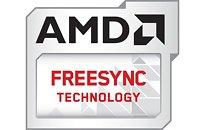Tuesday, June 5th 2018

AMD Introduces FreeSync Technology for New Samsung QLED TVs
AMD and Samsung today announced support for Radeon FreeSync technology in the new Samsung QLED 55" to 82" TV range, bringing the ultimate, ultrawide 4K gaming experience to an entirely new format - big screen TVs. Samsung is the first company to utilize industry-leading Radeon FreeSync adaptive refresh technology for stutter-free gaming inside a consumer television set. With High Dynamic Range (HDR) support up to 1000nits and stunning picture quality, Samsung's QLED displays allow gamers to experience strikingly high refresh rates and low latency on TVs at a variety of price points and screen sizes ranging from 55" to 82" creating a single display for all their home entertainment needs.
Over the past three years, Radeon FreeSync technology has driven widespread adoption and become the industry's most selected solution for smooth gaming. Earlier this year, AMD expanded the ecosystem by propelling tear-free gameplay beyond the PC with the launch of support for FreeSync technology in Microsoft's Xbox One S and Xbox One X consoles in early March. With more than 250 compatible displays offered by more than 20 partners, this is more than double the availability of competing technology."Whether you're a console or PC gamer, playing on a PC display or your living room TV, Radeon FreeSync technology powers exceptional stutter-free gaming experiences," said Scott Herkelman, vice president and general manager, Radeon Technologies Group, AMD. "We launched FreeSync technology with a mission to end frame tearing and dropped frames, as well as improve the experience for gamers around the world. With Samsung's FreeSync technology QLED TVs, extra smooth gameplay visuals have never been so accessible, and never in such a large and appealing format.""From the beginning, Samsung has embraced Radeon FreeSync technology and the commitment from AMD to deliver technologies based on open standards that enhance the gaming experience," said Chu Jongsuk, senior vice president at Samsung. "Our users demand the absolute best in visual quality, and that extends to smooth gaming low latency. We're thrilled to bring the power of Radeon FreeSync technology to Samsung TVs for players around the world."
"AMD and Microsoft have a long history of innovation, collaborating on hardware and software to bring gamers the best possible experiences," said Matthew Lapsen, general manager, Xbox Console Marketing. "With FreeSync technology support for our Xbox One platform, AMD and Microsoft brought a critical gaming technology to a broader base of gamers. We're offering a whole new caliber of smooth-looking gameplay to players on Xbox One S and Xbox One X."FreeSync technology for Samsung's 2018 QLED TV range is available today for the QLED 55" - 82" models and the NU8000 / NU8500 55" - 82" Series. This will be delivered as part of an automatic Gamer Mode update.
Over the past three years, Radeon FreeSync technology has driven widespread adoption and become the industry's most selected solution for smooth gaming. Earlier this year, AMD expanded the ecosystem by propelling tear-free gameplay beyond the PC with the launch of support for FreeSync technology in Microsoft's Xbox One S and Xbox One X consoles in early March. With more than 250 compatible displays offered by more than 20 partners, this is more than double the availability of competing technology."Whether you're a console or PC gamer, playing on a PC display or your living room TV, Radeon FreeSync technology powers exceptional stutter-free gaming experiences," said Scott Herkelman, vice president and general manager, Radeon Technologies Group, AMD. "We launched FreeSync technology with a mission to end frame tearing and dropped frames, as well as improve the experience for gamers around the world. With Samsung's FreeSync technology QLED TVs, extra smooth gameplay visuals have never been so accessible, and never in such a large and appealing format.""From the beginning, Samsung has embraced Radeon FreeSync technology and the commitment from AMD to deliver technologies based on open standards that enhance the gaming experience," said Chu Jongsuk, senior vice president at Samsung. "Our users demand the absolute best in visual quality, and that extends to smooth gaming low latency. We're thrilled to bring the power of Radeon FreeSync technology to Samsung TVs for players around the world."
"AMD and Microsoft have a long history of innovation, collaborating on hardware and software to bring gamers the best possible experiences," said Matthew Lapsen, general manager, Xbox Console Marketing. "With FreeSync technology support for our Xbox One platform, AMD and Microsoft brought a critical gaming technology to a broader base of gamers. We're offering a whole new caliber of smooth-looking gameplay to players on Xbox One S and Xbox One X."FreeSync technology for Samsung's 2018 QLED TV range is available today for the QLED 55" - 82" models and the NU8000 / NU8500 55" - 82" Series. This will be delivered as part of an automatic Gamer Mode update.




37 Comments on AMD Introduces FreeSync Technology for New Samsung QLED TVs
Wonder what the "Adaptive Range" is. Will likely look it up the closer I get to buying. Hopefully has a good low to high working range.
Is there support for more than 60Hz, in that case what refreshrate is that 120hz?
Consoles are the real key for this tech... and AMD won the fight.
Which is pretty sweet for those that own one.
Then they'll do special TV for consoles just like benQ who launched an official PS4 monitor with bad specs... I laughed at this one.
It's more useful than just in consoles. Like me, who occasionally wants to game in 4K.. but on more stressing games, might fluctuate at the 45-50fps mark. You won't notice the difference with Freesync.
Not sure about QLED, but this set can do 1080p at 120hz.. so I imagine the QLEDs are at least that or better.